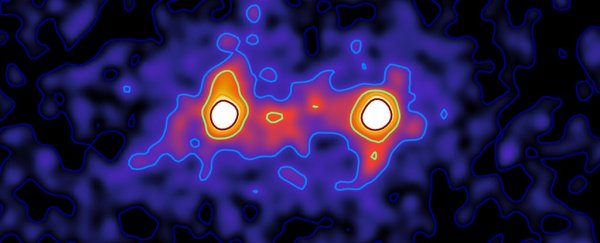In our eagerness to identity the Universe's occult phenomena of dark energy and dark matter, we often forget that most of its better defined particles also seem to be MIA.
Relax. We now have our first solid piece of evidence that this matter has been hiding in the delicate threads of cosmic webbing bridging neighbouring galaxies, right where the models predicted.
Two separate teams of astronomers used similar approaches to establish the presence of what is described as baryonic matter in the space between galaxies.
When the term is used in astronomy, Baryonic matter consists largely of the kinds of building-block particles listed in your high school physics text book, such as protons, neutrons, and electrons.
It's thought to only make up about 4.6 percent of everything, with dark matter and dark energy comprising the rest.
Astrophysicists can get a sense of how much of this matter is up among the stars and glowing gas clouds by studying the light they emit, and then multiplying this mass based on what we know about the size and density of the Universe.
But while you might imagine this adds up to a lot of particles, the calculated total falls well short of the amount that should have coalesced from the Universe's pool of radiation post Big Bang.
How short? About 90 percent of that ancient baryonic bonanza seems to be missing from the shinier parts of our cosmos.
A fraction of this missing matter could exist as diffuse halos of dust and gas surrounding galaxies like ours, but this still leaves a lot of baryons unaccounted for.
One big part of the problem is if the matter isn't spilling some kind of light or casting a shadow, we just can't spot it.
Discoveries in recent years that have established vast webs of dark matter stretching across space have made it increasingly likely that the normally visible matter has accumulated in filaments bridging galaxies.
Suspecting it is out there is one thing. Hard evidence is what astronomers needed.
It wouldn't be dense enough to block starlight or hot enough to provide a signature, making it hard to spot with most measurement techniques.
So both teams of researchers relied on something called the Sunyaev-Zel'dovich effect, a phenomenon that causes photons left over from the glow of the Big Bang to scatter into slightly higher energies as they pass through the electrons in the gases surrounding galaxy clusters.
Each team used data on pairs of galaxies taken from catalogues in the Sloan Digital Sky Survey. After sorting the pairs based on their relative orientation, the researchers stacked them to reinforce any faint patterns they might share.
One team, led by researchers from the University of British Columbia, found the density of these filaments to be just under three times the average density of baryons in the surrounding void.
The other team, from the University of Edinburgh, concluded the figure was about six times the average density.
"We expect some differences because we are looking at filaments at different distances," researcher Hideki Tanimura from the University of British Columbia told Leah Crane from New Scientist.
"If this factor is included, our findings are very consistent with the other group."
Expanded out over the cosmic web, the results go a long way in accounting for that missing matter.
Both studies are currently on the pre-publishing website arXiv.org, so you can dive into the details now ahead of their final peer reviewed publications.
Bigger surveys in the future will no doubt provide more data that can help define a more precise figure for the amount of visible matter collecting along the Universe's dark threads.
The fact two studies independently came to similar results is pretty strong evidence, though, reinforcing existing models on the Universe and the evolution of galaxies.
